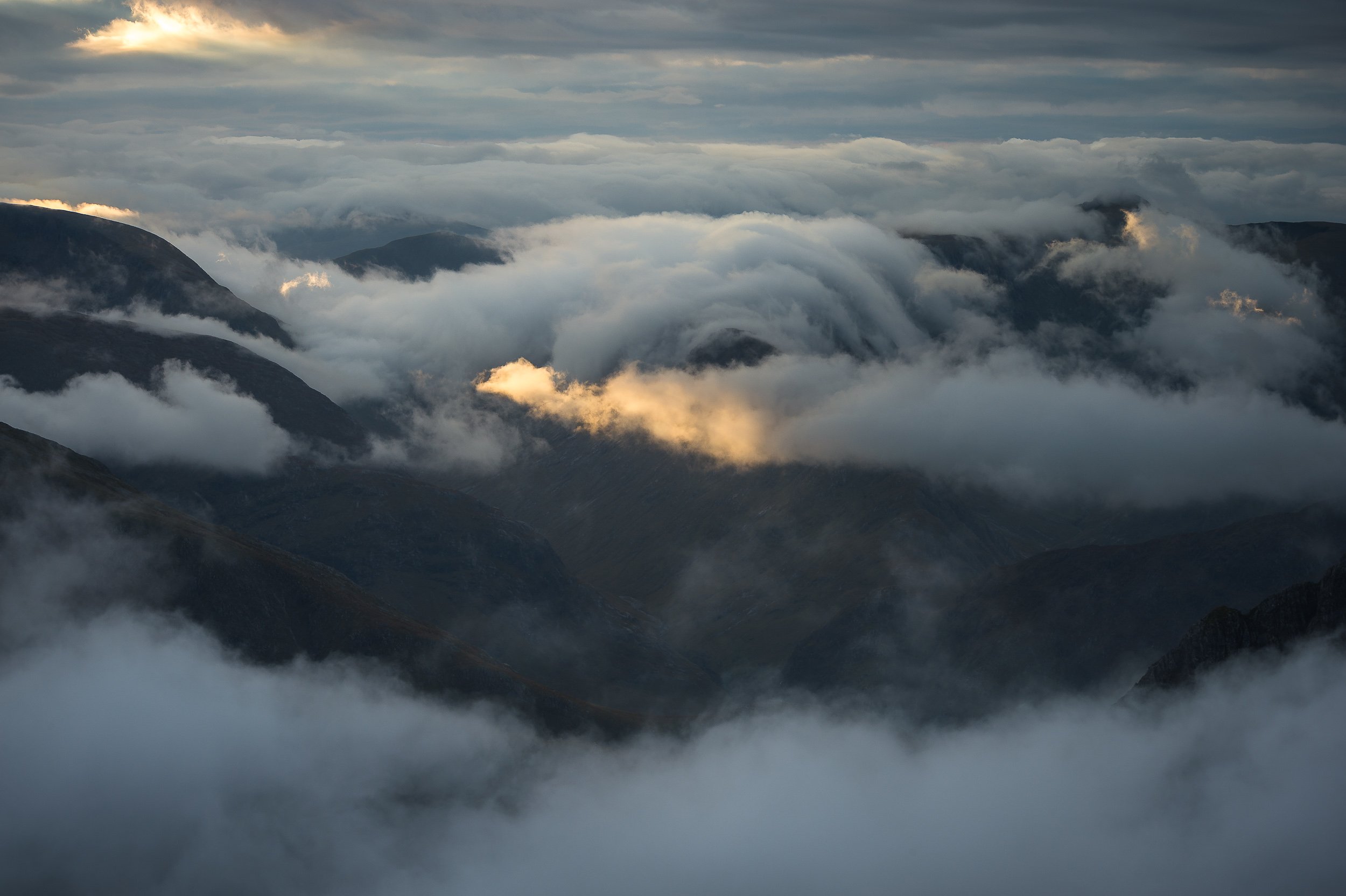Viewpoint — Glen Coe summit camp
Written for and published by UK Outdoor Photography magazine.
Each year, in Summer, I like to take a few weeks out of Scotland’s mountains to let the temperature cool down and remove myself from the scourge that is the Scottish midge. By the time the cooler months of September and October arrive, I’m looking forward to ending my self-imposed exile and heading back into the hills.
My goal for this occasion was to sleep atop a mountain peak, photograph the sunrise for a personal client and scope out a location for a mountain running photo shoot I had pencilled in for later in the year. The internet is such a valuable resource these days for a landscape photographer and there’s many useful tools that will aid your planning (such as Google Maps, Google Images, Fatmap or the Sunseeker or Photographer’s Ephemeris mobile apps). You can research in detail exactly which locations should be worth going to and when, with the huge advantage of knowing in advance where the light will fall. A great deal of work can be done at home or in the office and if you’ve planned correctly, it’s simply a case of waiting and hoping for a spell of good weather.
For this trip, I’d researched an ascent of Stob Coire nan Lochan, a 1115m high rocky summit above Glen Coe in the West Highlands of Scotland, part of the Bidean nam Bian massif. I’d worked in Glen Coe before and relished the idea of heading back. For good reason — the landscape is incredibly varied for such a small place.
Parking is available at the popular Pass of Glen Coe and, in the early evening, I trekked into Coire nan Lochan, enjoying the effort of my ascent as darkness fell. The ground was familiar as I’d been in the corrie before, on route to a popular winter climb called Dorsal Arete. Scrambling up the rocky flanks of Stob Coire nan Lochan by head-torch was interesting and good fun and I was welcomed on the summit by cool, dry air, carried on a slight breeze. Settling in to my warm bivvy, I listened to the sound of stags braying loudly in the glens below and soon fell asleep.
Early morning light
One of the benefits of photographing in Autumn is you don’t need to be up super early to catch the dawn. Sunrise was indicated as 7:37am and I was up at a very pleasant time of 7.00am. As I expected, I was on my own, with an uninterrupted 360-degree view of Scottish glens and mountains. Swinging my arms to warm up (I hadn’t brought a stove, to save weight), I set up my tripod, camera and wireless trigger in the gloomy light of pre-dawn, pre-visualised compositions I felt would be worthy to photograph and waited to see what would happen. Unfortunately, I wasn’t blessed with the most colourful sunrise but I was witness to some wonderful views as clouds formed in the glens beneath me and, as they rose they draped over the peaks, shafts of light piercing through the clouds and lighting up the landscape.
In all, I spent a very special few hours, in beautiful silence, switching between wide angle and telephoto lenses and shooting as many different compositions as I felt were worthwhile, lingering until dawn had truly broken, and the interesting light had gone. I then packed up and climbed to the summit of Bidean nam Bian (one of the 282 ‘Munros’, Scottish peaks over 3,000ft high), continuing along an easy ridge to a second Munro, Stob Coire Sgreamhach, before I retraced my steps to the head of the evocatively titled ‘Lost Valley’, and headed for home.
Viewpoint information
Distances in miles from nearest large town and nearest city
17 miles from Fort William
118 miles from Edinburgh
81 miles from Inverness
Access rating
5 — Mountain summit reached by some rock scrambling
How to get there
Travel the A82 road to reach the obvious main car park in Glen Coe. Depending on the time of day, this car park may be very busy and a bagpiper playing to the crowds — some smaller parking locations are nearby. Climb the path into Coire nan Lochan — one easy scrambling bit — then, when you each a prominent waterfall, head left on scree and scramble on slightly more difficult ground up the east ridge of Stob Coire nan Lochan to the summit. (A map and compass and the skills to use them is essential. Visit a dedicated walking resource, e.g. www.walkhighlands.co.uk, for more detailed instructions).
What to shoot
Wide angles of remote glens and mountain ridges with the A82 road, c.2,500ft beneath your feet. Switch to a telephoto zoom lens and pull out detail in the rocky cliffs beneath the summit of the nearby Munro, Bidean nam Bian (the highest point in Argyll). The infamous Aonach Eagach or ‘notched ridge’ is straight across the glen.
Best time of day
Any time of day for general photographs (expansive 360 degree views from summit). Best at dawn for the sun lighting up the glens and peaks to the east. Bivvying the evening before on Stob Coire nan Lochan is an option but the summit is very rocky and not altogether flat.
Nearest food/drink
Clachaig Inn, Glencoe, Argyll, PH49 4HX
W: www.clachaig.com
E: frontdesk@clachaig.com
T: +44 (0) 1855 811252
Nearest accommodation
Clachaig Inn, Glencoe — www.clachaig.com
Kingshouse Hotel — www.kingshousehotel.co.uk
Other times of year
Winter and Spring light in Glen Coe can be magical but mountaineering knowledge, skills and equipment are required to reach the summits when the ground is covered in snow and ice.
Ordnance Survey
OS Landranger map series 41 — Ben Nevis Fort William & Glen Coe
Nearby photography locations
Buachaille Etive Mor — 1 mile
Loch Etive (Glen Etive) — 17 miles
Lochan na h-Achlais (Rannoch Moor) — 11 miles











